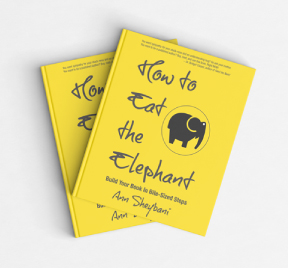Writing
How To Write A Parable
October 9, 2016
If you’d like to outline your message and be seen as an expert in your field, you’d be silly to write a novel. If you’re not keen to write a non-fiction business book, then perhaps you’d like to pen a parable.
The parable is a particularly appealing genre for business writers who recognize that readers learn best, not from an endless stream of concepts, but from a simple story, one that doesn’t take seven years to write.
A parable is a short(ish) tale that illustrates a universal truth. (It’s often clumped together with similar narrative types, such as the allegory and fable. For our purposes, let’s assume they’re pretty much the same because each form encourages readers to look for meanings beyond what is said.)
According to Wikepedia:
A parable often involves a character who faces a moral dilemma or one who makes a bad decision and then suffers the unintended consequences. Although the meaning of a parable is often not explicitly stated, it is not intended to be hidden or secret but to be quite straightforward and obvious.
The defining characteristic of the parable is the presence of a subtext suggesting how a person should behave or what he should believe. Aside from providing guidance and suggestions for proper conduct in one’s life, parables frequently use metaphorical language, which allows people to more easily discuss difficult or complex ideas. Parables express an abstract argument by means of using a concrete narrative, which is easily understood.
In a nutshell, the aim of the parable is to convey complicated moral truths in such a way that they become relateable, understandable to one’s own life.
Some of the best known business parables include The Go-Giver, Life’s Golden Ticket, The Richest Man in Babylon, and The Monk Who Sold His Ferrari, all of which I’ll send my clients when they need a good model.
So, how do you go about writing a parable?
Well, I’ve got some good news: The parable is remarkably formulaic and I’m going to give you the formula.
1.Start with the moral lesson. Think about a moral principle that’s been important in your business or your life, one that, if grasped, could make all the difference to your client’s success. (Remember, your potential client is the audience you are writing for.)
In The Go Giver, the moral lesson can be boiled down to this: The secret to success is giving. In The Richest Man in Babylon, it’s this: Money is plentiful for those who understand the simple rules of its acquisition.
To come up with such a succinct moral lesson takes some doing, particularly if you intend to make it relevant to your target audience/market and the big result you give them. (Hint: This is precisely what you want to do.)
If none pops to mind, you may need to spend some time brainstorming.
Here are some ideas to get you thinking:
- Slow and steady wins the race
- You attract more flies with honey than vinegar
- Beauty is in the eye of the beholder
- Children learn by example
- Money can’t buy love.
At the end of the day, your reader (right along with your main character, your protagonist) will understand this moral lesson, this big concept in an entirely different way. He’ll smack his forehead and say, “Of course, how did I not know this before? How could I have been so blind to something this obvious?!”
In essence, we must start with the end in mind.
2. Make a list of the mini lessons to be learned along the way to ultimate understanding.
In The Go-Giver, the protagonist, the hero of the story, has to learn several mini lessons before he finally understands that one big moral lesson at the end—The secret to success is giving.
Bob Berg, the author of The Go-Giver, doesn’t call them mini-lessons; instead he calls them laws. They include:
- The law of value—Your worth is determined by how much more you give than you take in payment.
- The law of compensation—Your income is determined by how many people you serve, and how well you serve them.
- The law of influence—Your influence is determined by how abundantly you place other peoples interests first.
- The law of authenticity—The most valuable gift you have to offer is yourself
- The law of receptivity—The key to effective giving is to stay open to receiving.
George Samuel Clason, the author of The Richest Man in Babylon, doesn’t call them mini-lessons, either; he calls them cures. The Seven Cures include:
- Start thy purse to fattening
- Control thy expenditures
- Make thy gold multiply
- Guard thy treasures from loss
- Make of thy dwelling a profitable investment
- Insure a future income
- Increase thy ability to earn
Call them what you will—mini lessons, laws, or cures—these are the sign posts you must hit to create a satisfying narrative arc, and to lead your reader (and protagonist) to a full understanding.
3.Consider the consequences. What might happen as a result of behaving (or not behaving) according to your moral lesson?
In Aesop’s fable, The Man, The Boy, And The Donkey, the consequence of worrying about what everybody thinks is that you loose your ass. You’ll never please everybody, and that lesson comes at a great cost.
If you have a concept, such as “don’t put off until tomorrow what you can do today,” think of ways that you see that in your day-to-day life.
Your mini lessons, they have consequences too.
4. Write a beginning, middle, and end. All stories follow a basic beginning-middle-end structure, and parables are no exception. The beginning sets the stage and tells us who all the main characters are while establishing the problem, the result of not understanding our moral lesson. In the middle, we build on the problem; face a series of conflicts; and in the end, we learn about the results of that conflict. We come to a new understanding.
Now, the consequence of not behaving according to your moral lesson must be dramatized in your introduction. This is where you show your main character, your protagonist, in full struggle mode. How is his life falling apart? What is he about to lose because he doesn’t understand how things really work? Is he about to go bankrupt because he doesn’t understand the rules of acquisition? Is he about to get fired because no one wants to do business with him, what with his selfish approach?
Each of the mini lessons must be dramatized as well, preferably in their own separate chapters. Take your protagonist and drop him in a new environment. Introduce him to someone new who can teach him the mini lesson. Create a guide to lead your protagonist from one learning environment to the next, who can serve as a teacher throughout the journey. This is the middle of the book.
Finally, show us how life changes for our protagonist when he finally understands the big moral lesson. How does his life improve? Does he get the big raise? Does he learn to speak fearlessly in front of big crowds? Does he accept the decision he has made with no second-guessing? Show us what that looks like, how that feels.
Parables are powerful ways to demonstrate your expertise and communicate important business lessons. Follow this simple framework for success.



